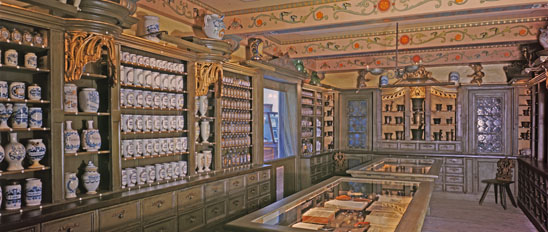The mortar, the symbol of the apothecary, is arguably the oldest of all pharmaceutical equipment. Mortars are made from a variety of materials, including bronze, marble, wood, brass, glass and stone. Apothecaries would have numerous mortars and pestles of various sizes and materials in their shops for different tasks: large mortars were used for bulk material, smaller mortars for grinding fine powders
The majority of the mortars in the Bristol-Myers Squibb European Apothecary collection are made from bronze, an alloy composed of copper and tin. Bronze is sometimes referred to as bell metal, as it was often used in the manufacture of bells for monasteries and churches. Heavy and highly ornamented bronze mortars were made as early as the 12th century, eventually falling out of favor with the introduction of porcelain mortars in 1779 by Josiah Wedgwood.
The earliest mortars in the collection resemble tankards with vertical Gothic ribs. Mortars from the 16th and 17th centuries are elaborately decorated with horizontal decorative bands of flowers and geometric-designs; inscriptions; heraldic shields; and figures of people, animals and insects.
Several of these early mortars have been analyzed with an x-ray fluorescence spectrometer in order to determine their composition. The results are recorded within the descriptions of the individual mortars.
In 1983 Dutch pharmaceutical historians Wolfgang-Hagen Hein and D. A. Wittop Koning visited the collection. After assessing the collection both Hein and Koning wrote letters to the curatorial staff commenting on issues regarding the provenance and the authenticity of mortars and drug jars. Their conclusions have been added to the catalogued descriptions, along with those of the original cataloguer George Urdang.
